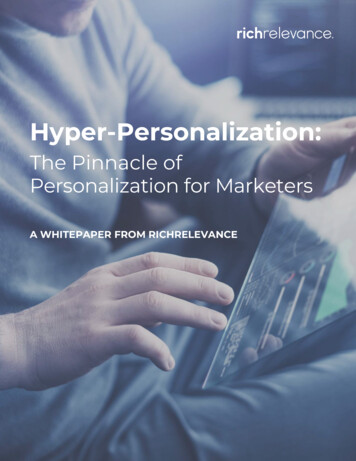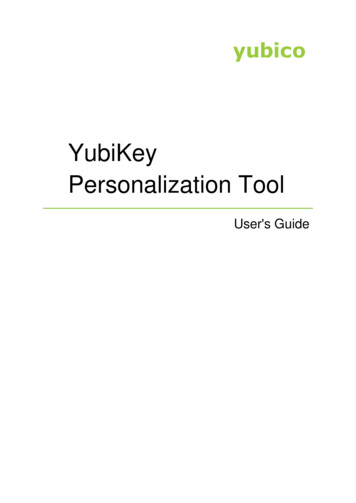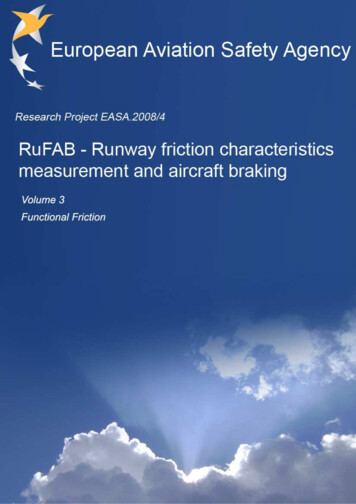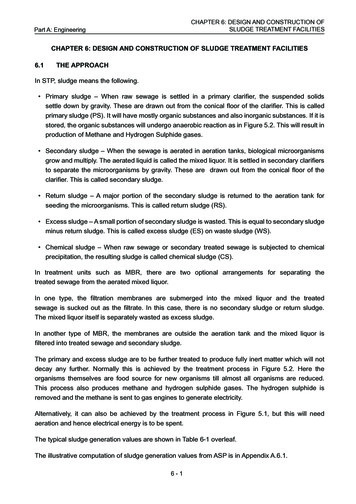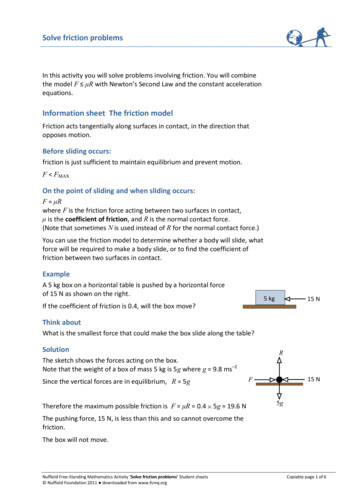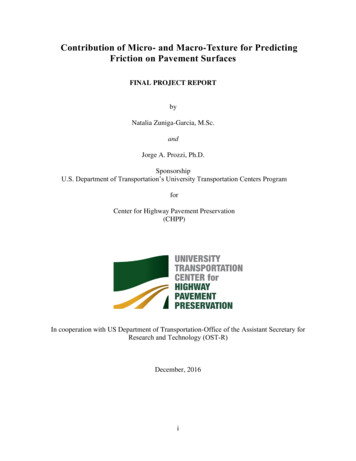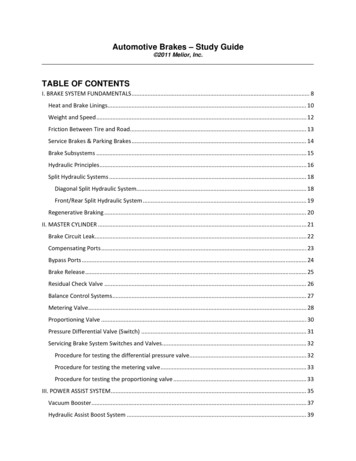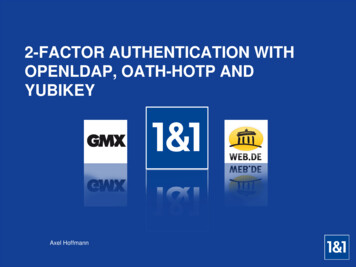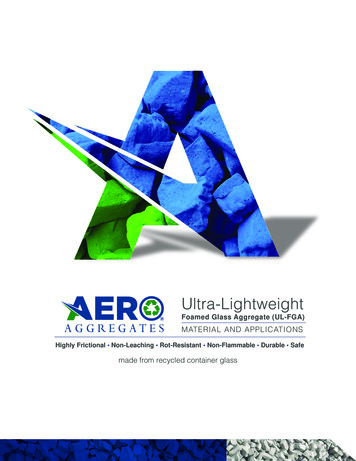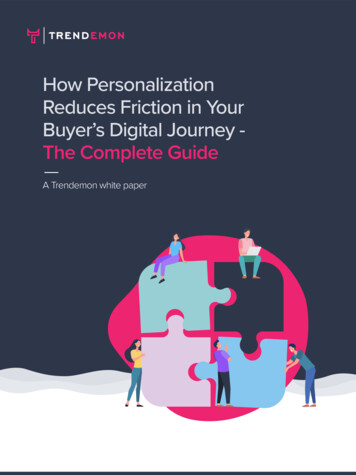
Transcription
How PersonalizationReduces Friction in YourBuyer’s Digital Journey The Complete GuideA Trendemon white paperHow Personalization Reduces Friction in Your Buyer’s Digital Journey - The Complete Guide A Trendemon white paper1
IntroductionWhy should marketing organizations invest in it?When would be a good time to start?How to build digital experiences which reduce friction in your potential customers’ journeys?What are some benchmarks you should be aiming for?Which solutions may be the right ones for you?Clarification: Personalization can take place on various channels - your website, emails, and evenprint can be personalized. In this paper, we’ll focus on web experiences, and about personalizing andorchestrating digital journeys as opposed to personalizing specific elements of a page or single userinteractions.How’s this paper structured?We tried writing this paper in the form of a dialog rather than a lecture. We re-asked ourselves the questionswe’ve been getting in recent years on these matters. As we say in our neck of the dunes, “Yalla ”You’re a vendor and you have an agenda,so why should I trust anything you say?Yes, we are a tech vendor. We sell a platform which helps B2B organizations reduce friction from theirbuyer journeys. Yes, we would like our own business to grow. But, just as our technology is built to helpcompanies grow, our content is aimed to help them achieve that too.More to the point, we actually lay out in this paper when is a good time to consider implementing apersonalization platform (spoiler: not anytime, not for any size); and which infrastructures you may needbefore prioritizing personalization. We’ve seen these factors as more significant for the successfulimplementation of a personalization platform than any specific tool or solution.Ok, even if I believe your intentions are genuine,why should I pay attention to what you’re saying?We’ve been working with over 100 B2B marketing organizations to build and manage personalized digitalexperiences. Before that, the company’s leadership had another 10 years of experience under its beltin the digital marketing space as a service provider (marketing agency). Apart from our mileage, we’reworking today with leading, fast growing tech companies who are writing the playbooks on growth viadigital channels.Lastly, we have data. Oodles of it. With over 1.4 gazillion customer journeys analyzed (or thereabouts ), wecan spot patterns across industries, and validate or disprove claims. More importantly, since we’re mappingjourneys down to the pipeline and revenue levels, our insights are tied to , not likes, views, shares or anyother engagement KPI that marketing is sometimes associated with.How Personalization Reduces Friction in Your Buyer’s Digital Journey - The Complete Guide A Trendemon white paper2
Table of ContentsWhy Personalization - Why reducing friction across your customers’ journeys will exponentially increaseyour assets’ outputsWhy consider personalization now?The cost of not doing it - how friction, the silent killer, kills unborn deals449What do we mean when we say personalization?11When is the right time to invest in personalization?14How to craft seamless experiences with personalization, and how to orchestrate complete journeys?15Which solution is the right one for you?23How Personalization Reduces Friction in Your Buyer’s Digital Journey - The Complete Guide A Trendemon white paper33
WhyIn this section, we answer the questions of why personalization is essential to reaching customers onlineright now, and why reducing friction across your customers’ journeys will exponentially increase yourassets’ outputs. We also dive into the cost of not doing it and see how friction kills deals.Why Personalization, and Why Now?52% of marketersrecognize mapping experiences and personalizingthem as the most effective methods to engagepotential customers online.However,45%also view these abilitiesas the most challenging toexecute properly.Why is orchestrating an effective personalization strategy so challenging? We can see several reasonsbehind this:1. Requires significant bandwidth to craft differentiated experiences2. Requires deeper insights as to what is actually resonating with different audiences3. Requires previous knowledge as to what specific individuals have already seen, where they camefrom, and what could be their objectives.Tactical EffectivenessVersus Difficulty Survey ResultsCustomer experience mappingPersonalized/dynamic contentProspect/customer re-engagementMost effective53%43%46%37%51%40%Most difficultSource: pdfTraditional B2B marketing is usually focused on capturing leads first, and chasing/nurturing after. Thisapproach was clear at conferences (“Hey, win a chance to get a drone if you give us your businesscard ”), as well as online (such as sending new visitors to landing pages where the promise for greatcontent in exchange for the info was made).How Personalization Reduces Friction in Your Buyer’s Digital Journey - The Complete Guide A Trendemon white paper4
Transitions During 2020-2021 Following COVID-19In B2B marketing, this has been the paradigm for several years – until, in 2020, something changed. To beexact, everything changed. Channels and activities that used to be the mainstay of lead generation andmarketing activities, like conferences and tradeshows, became irrelevant almost overnight. Field marketingand sales had to rapidly transform and reinvent themselves as 100% digital-based. Many B2B marketingteams moved from a situation where they’ve had several main events throughout the year, which theycounted on as their primary sources of lead generation, to a new state of needing to create continuousengagement with many prospects in their digital channels.Content as mid-funnel playerStage:Activities& PlatformsAwarenessNurtureClosingConferences& CampaignsContent(email & website)MeetingsContent as all-funnel playerStage:Activities& PlatformsAwarenessNurtureClosingCampaigns,Webinars & ContentContent(email & website)Emails Content / ZoomsHow Personalization Reduces Friction in Your Buyer’s Digital Journey - The Complete Guide A Trendemon white paper5
The Acceleration of Digital Transformation Following COVIDWe usually hold a relatively linear view of progress and evolution, expecting things to develop gradually.However, every once in a while, we get a strong reminder that evolution happens in jumps rather thancrawls. In scientific terms, it's referred to as punctuated equilibrium - the theory that species don’t adaptso much in a gradual, continuous manner, but rather make evolutionary leaps when sudden changeforces them to adapt quickly.ChangeTechnology changes exponentially,but organizations change logarithmically.fastMartec's Lawengahlcagiccataclysmicoloeventnhcteal changenotiaiznargorapidadaptationslowTimecredit: chiefmartecHow Personalization Reduces Friction in Your Buyer’s Digital Journey - The Complete Guide A Trendemon white paper6
Companies say COVID-19 hasaccelerated their digital communicationstrategy by 6 yearsAbout how many years has COVID-19 accelerated the schedulefor your digital communications strategy?50%43%40%30%27%19%20%6%4%2%0%None1-4 years5-9 years10-14 years15 yearsDon't know 2020 Twilio All Rights Reserved10%Base: 2,569 Companies / Midpoint average of 2,528 companies / Don't know' removedAccelerating the Convergence of Digital Experiences The Seamless Journey We’ve All Come to ExpectRemember the time you signed up for Netflix? Or Spotify? Probably not. It was so quick, seamless, andintuitive that there’s a good chance you won’t recall it. Now look at a typical buying process of enterpriseor B2B software or product. Now back to Netflix - how is your content browsing experience there? Nowback to your B2B app notice the differences?Modern B2B buyers expect seamless, effortless, and contextual experiences similar to their experiencesas consumers. They are usually bitterly disappointed.How Personalization Reduces Friction in Your Buyer’s Digital Journey - The Complete Guide A Trendemon white paper7
How B2B Buyers Are Becoming More Like B2C ConsumersJust as content and its role have evolved over the past year, so has the B2B buyer. The graphic below,taken from Forresters’ The B2B Consumer Grows Up, illustrates how the new B2B buyer more closelyresembles the traditional B2C buyer, and therefore now expects similar seamless, contextual experiences.When you think of it, why wouldn’t they? When we buy on Amazon, listen on Spotify, or browse Netflix, wecome to expect a seamless journey. We expect those systems to delight us with effortless experiencesand predictive, contextual content. Those expectations then follow us even after we remove our consumercap and put on our B2B hat.TraditionalB2B TraditionalB2C MutableThe newB2B MutableVia ForresterGuiding vs. GatingThat change in the expectations of the B2B buyer, leads us to a painful topic among marketers - to gateor not to gate.B2B buyers realized that once their email was surrendered, they became targets for relentless droves of salesdev representatives. People became less willing to leave their contact info in exchange for some content.Here’s a stat that provides a clear indicator of that trend:78%of Gen-Xers to Millenials won’tfill a form to get informationHow Personalization Reduces Friction in Your Buyer’s Digital Journey - The Complete Guide A Trendemon white paper8
So, marketers today are seeking new ways to deliver better experiences and communicate with their targetaudience even without their contact info. Some of these new ways include chatbots or, not surprisingly,on-site personalization. Almost half of the b2b buyer journey on the website is at the pre-lead, anonymousstage. This data emphasizes the need to guide users on the site without having their personal information- as opposed to gating content, which will cause most relevant visitors today to disengage.We see the most successful marketers manage to strike a delicate balance between providing valuable,accessible content, and gating some bottom-of-the-funnel deeper items. While there still is a role forgating content, we believe it shouldn’t be a choice for the first interactions you create with potentialcustomers.Friction - the Silent Killer of DealsWhen sales lose an opportunity or when a customer churns, companies sometimes will perform a lossanalysis to uncover what went wrong, and see what they can improve next time around. When a potentialcustomer leaves before even engaging with the sales team or becoming a lead due to a bad experience,no one is aware. Besides losing deals, that gap means no steps are taken to close those leaks from thefunnel.Here is a key figure to keep in mind: on average, 80% of your buyer’s journey is done anonymously.Furthermore, 45% is actually done on your assets, in places where you can actually control these experiences.In the following graphic you can see a visualization of a typical B2B journey and its distribution betweenexternal and internal assets, known and unknown stages:The External, Unknown and Known Stagesof B2B Journey35%visits website45%sign up20%External Exposure & ResearchAnonymous Research on your siteKnown contact8-12 exposures10-15 reads4-7 readsExposure Establish TrustEducation Establish ExperiseEngagement Establish NeedHow Personalization Reduces Friction in Your Buyer’s Digital Journey - The Complete Guide A Trendemon white paper9
The Impact of Personalized Experiences on EngagementWe see that just by adding personalized recommendations, websites quadruple their levels of engagement(measured as CTR on those units) - going up from 0.75% CTR for non-personalized recommendations to3% to personalized content recommendations.This uplift is critical, since if every visitor needs to reach a certain number of effective touchpoints (“reads”)on our assets, that increase in CTR can be the difference between a journey that takes 6 months tocomplete vs 1.5 months. Apart from accelerating journeys, increased readership and engagement on yoursite can be the difference between a prospect moving forward or dropping at the upper stages of theirjourney. To understand this better, let’s look at how personalization affects actual pipeline and revenue.The Massive Impact of Audience Targeting on CTRAs we dive deeper, we can see which additional factors have the greatest impact on CTR. Marketing is all aboutfinding levers - places and activities that, with a relatively small investment of resources, can yield significantreturns. This is exactly what we’ve seen when companies go beyond basic personalization and target entireaudiences on their site. In the numbers mentioned above, we’ve seen that basic personalization can take youup from 0.75% to 3% engagement. To increase CTR, audience-based targeting (meaning the grouping ofusers in buckets based on personas/accounts/etc.) can push performance even further. Much further:Recommendations Benchmark ChartNon-personalized recommendations0.5-0.75% CTRBasic personalization2-3% CTRAudience targeting7-12% CTRWhy is audience-based targeting such a powerful lever? Because once you’ve set your audiences,populated them, and attached the relevant pools of content, this single investment in time will translateinto an ongoing exponential increase in engagement. Once these audiences have been set, you canfocus on the creation of quality content within those pools.The Impact of Personalized Experiences on RevenueIn B2B companies with ACVs of up to 50K, we see personalization contributing to about 12-19% uplift inpipeline opportunities. Annually, this translates to uplifts of 3M for companies with 20M Annual revenue.In B2B companies that sell products with high ACVs ( 200K ACV), the uplifts can be between 8-11%.Personalization plays a greater role in the Sales Development process, where we see personalized hubsracing 15-20% CTRs when sent to prospective buyers.TL;DR - So, personalization in those companies is more effective at the lower stages of the funnel (suchas post-lead, sales enablement) as opposed to smaller ACV companies, where personalization is moreeffective at the upper stages.How Personalization Reduces Friction in Your Buyer’s Digital Journey - The Complete Guide A Trendemon white paper10
WhatIn this section, we define personalization, and take it apart to see its various levels and benchmarks to aimfor. Then we show you how personalization is driving change in B2B customer experience expectations.What is Personalization, Really?Personalization is a loaded and ambiguous term. Two marketers will have three different opinions on what itactually means. Some view it as the ability to change the name in the subject line, while others see it as theability to serve different recommendations for products or content based on the users’ history.As opposed to discussing capabilities or features, let’s start with what we think it means to be able to providea personalized experience. At its core, we view personalization as a way to conduct personal communicationat scale.Taking this notion to the extreme means that an organization is able to conduct an infinite number ofconcurrent dialogs with prospective customers. Dialogs do not have to be literal conversionations, likeyou may expect to have with a live representative or a virtual one, such as a chatbot.A dialog requires the ability to listen and respond in a valuable and contextual manner. When it comes todigital marketing, people don’t necessarily have to verbally communicate to you what they want. Thereare many signals people emit online. What if you could leverage those signals to interpret their intentions,needs, and wants?How Personalization Reduces Friction in Your Buyer’s Digital Journey - The Complete Guide A Trendemon white paper11
What Are the Main Levels of Personalization?To help make some order, here’s a general categorization of kinds of data a personalization engine can leverage:Identity-basedThis is the most common type and what most people think about when they hear aboutpersonalization. A personalized email will usually include your name, a personalized call-to-actionmay be based on the company you are visiting from, and so forth. Essentially, the system usesidentity-based information to tailor the experience. Identity-based can be divided into 3 levels:a. Localization (Geo, Language)b. Account-Based (Company)c. Specific User (email, name, etc. if they’ve already signed up)The problem is that beyond knowing who you are, it lacks the context of where the user is tryingto get. This gets us to the next level:Journey-basedThis type of personalization uses historic information about places the user visited, pagesthey’ve engaged with, and topics that may have interested them. A common type of this kindof personalization is product recommendations. Based on products you’ve purchased in thepast, Amazon can recommend related products. This also applies to content recommendations based on articles you’ve read, the system can recommend other content from those topics/fields.However, knowing what to recommend in order to move a user forward in their journey requiresanother layer of data:Attribution-basedIn this case, we’re using attribution and/or performance data to know which information to serve theuser. In a B2B buyer journey, this would mean that out of the hundreds of posts we can recommendto a user, instead of just recommending content based on a similar topic, we can recommendcontent based on what actually helped similar users move forward towards some business goal(for example, becoming an SQL).How Personalization Reduces Friction in Your Buyer’s Digital Journey - The Complete Guide A Trendemon white paper12
Personalization LevelsWho? Geo, Language Account / Industry When/Where? Behavior, Page Visits, Read Time Attribution? What Are They ConsumingUltimate PersonalizationA few notes on the above categorization:If you’re wondering why we don’t include “AI-based” personalization, it's because AI is a general approachand tools to data science, not a specific type of data we would be leveraging. You can use AI to improvein any of the above types.Naturally, when possible, you can (and should) incorporate several types of data to improve theeffectiveness of your engine.How Personalization Reduces Friction in Your Buyer’s Digital Journey - The Complete Guide A Trendemon white paper13
WhenIn this section, we answer the question of when is a good time to consider onboarding a personalizationsolution? We also delve into what building blocks and capabilities should you already have in place, beforelooking to augment your stack with personalization.Do I Have Sufficient Traffic?Before prioritizing reducing friction, you should probably ensure that you have sufficientmovement through your assets. What’s an adequate amount of movement? Our recommendationis to look at the number of conversions per month as opposed to topline traffic figures. Areyour assets responsible for some meaningful amount of relevant signups per month (for smallcompanies, this can be as little as 20-30 signups per month, while for others, hundreds)? If so,the fact that there already is some movement throughout your website, blog, and assets meansthat you have some sources of acquisition in place (organic, paid, or some combination) - a wayto engage, capture, and later close these prospects.Do I Have Sufficient Content Assets (Posts, Whitepapers, etc.)?On average, we see that only 15% of the content that companies produce actually impacts salesand pipeline. That means that out of 100 posts, you would have only 15 items that are actuallyhelping your customers move. We recommend that you have enough assets to build a 10-15item-long journey, as most B2B journeys would require at least this number of touchpoints andmaterials.Does My Team Have Sufficient Bandwidth?Like any meaningful activity, personalization requires some bandwidth. The most successfulcompanies we work with have a clear owner of this domain. That’s not to say you need a full-timeemployee just to manage a personalization platform, but this resource should be able to spend atleast 1-2 hour a week on this. A bit like managing a media campaign on a network, about 30% ofthe time is spent on creating campaigns, while the other 70% goes to optimizing and testing them.Do We Have Sufficient Data and Tech Infrastructure?Personalization is fueled by data. The better and deeper the data you can leverage, the betterperformance you can get out of your personalization efforts. The more this data has to do with thecompany’s business goals (like sales, pipeline, etc.), the better the alignment.From what we’ve seen, companies that would be good candidates to start exploring personalizationhave a connected CRM and marketing automation platform in place which has already collectedsome critical mass of data. Also, we see that companies that are starting to invest in ABM solutionsand acquisition efforts also can augment their performance with personalization.How Personalization Reduces Friction in Your Buyer’s Digital Journey - The Complete Guide A Trendemon white paper14
HowIn this section, we’ll discuss how to build a personalization strategy, the ways we can deploy it on ourassets, and how we measure its success. A personalization strategy is built in stages. First, we’ll review thevarious types and interfaces personalization can take place. Then, we’ll discuss how to use personalizationto orchestrate complete journeys, down to the closed-won stage in the CRM. These can be journeys ofindividuals as well as for accounts.How to Create Seamless ExperiencesTo help make some order, here’s a general categorization of kinds of data a personalization engine can leverage:Outline your target personasThe first question we should ask ourselves is whether we have a clear understanding of our target personaor personas. Digital Communication, much like any other communication type, works best when you knowwho you want to be speaking to and why. If you’re still not sure who your ideal customer is, crafting personalexperiences becomes a much harder task.What are some common types of audience targeting options?Who will get a personalized experience?Before we get into more complex operations of orchestrating journeys, let’s discuss the individual buildingblocks which enable delivering personalized experiences.Audiences are based on engagement, based on identity/geo/incoming source, and/or based on stage injourney. The most fundamental question in personalization we should be able to answer is who we want tosee this content/message/asset.The answer to the question who a certain visitor is will evolve over time. It will change because:1. You may get more information about that visitor which will help you paint a more complete picture oftheir identity.2. They may take certain actions on your site which will provide you more insights as to their interests andintentions.For instance, when an anonymous visitors first comes to your site, you can infer the following details:From which referral website or campaign they’ve arrived from - if you’ve targeted a certain audience ona network.From which IP address are they browsing your website - enabling you to know from which country orregion and sometimes also from which company.Later, they may sign up, giving you their name and email. Now, you have more data to be able to personalizetheir experience. You can know their title/position, and specific company. Then you can connect it to theirprevious journey to know what they were interested in.How Personalization Reduces Friction in Your Buyer’s Digital Journey - The Complete Guide A Trendemon white paper15
Which common interfaces does personalization usually include?Where can you incorporate personalization on your site?Website personalization does not mean having to completely change the entire look of your website dependingon your visitor. It can include strategically placed units which nudge visitors in the right direction. Two main typesof layouts which perform best for our customers are Embedded Recommendations and Image Call-to-Actions.Here are six of the most common personalization interfaces:1. The Embedded Recommendations Unit - Seamlessly educatingYou’ve seen these units at the bottom of almost any blog post. However, in most cases, we see thatthese units are either not personalized at all (so will show content which I’ve already read) or are onlypersonalized based on prior reads, with no weight given to the actual impact of the assets or post, itsoptimal position in the buyer journey, and relevance to my persona.How Personalization Reduces Friction in Your Buyer’s Digital Journey - The Complete Guide A Trendemon white paper16
2. The Embedded Call-to-Action (CTA) - Interacting without interferingThe embedded CTA is a useful way to engage and move into action, without interrupting the readingprocess. These units can appear anywhere in the post, but we see best results when they are somewherein the second half of the post.3. Overlays - Capturing attention with relevant offersI love pop-ups, said no one ever. However, if done correctly, they can be very effective. Personalizedcalls-to-action in overlay form can show your visitors information and offers which could be very usefuland timely. Here are some examples of engaging, high CTR units which we’ve seen dramatically increaseconversions:How Personalization Reduces Friction in Your Buyer’s Digital Journey - The Complete Guide A Trendemon white paper17
4. Sliders & Bars - Surveys, recommendations, and mini-formsAnother group of interfaces are the sliders and bars. Basically, like the screen overlay, they appear overthe page but they don’t block/hide the main content area.5. Content Hubs - a personalized destination for your target personasAs opposed to individual units, content hubs are entire URLs or destinations which serve personalizedcontent to personas or even specific accounts. They are a great landing spot for helping prospectscontinue their journey after initial engagement or signup, and also as a follow-up on a discovery salescall. The content in these hubs can be automatically generated or manually configured, depending onthe personalization platform you use and its capabilities.How Personalization Reduces Friction in Your Buyer’s Digital Journey - The Complete Guide A Trendemon white paper18
4. Changing certain elements within the pageAnother popular type of identity-based personalization is to substitute titles and areas within a page.For example, show users entering your customer stories area not a generic set of case studies, buttargeted assets based on the industry they are arriving from.When Should You Show Personalized Units or Calls-to-Action?The principle here is to use various behavioral signals to know when to trigger these units. A classic exampleis exit-intent pop-ups. If a user is about to leave, you have another chance to try and engage them withadditional content or offers. Another trigger we see work well is after a page has been fully read (measuredby a combination of scroll depth and time on page).Which Assets to Show? A Page for Every StageThe last question, and equally important as the first question “Who?”, is “What to show them?” This is the partwe see most marketers get wrong. Naturally, if you are trying to converse with your visitors, knowing what tosay to them is perhaps even more important than who they are.Again, to make things a bit simpler before we go and make them more complex, here are some types of assetsor questions:a. Do they agree to being served personalized information? Have a dialog with your visitor if they wish toreceive a more personal experience, what they wish to see, and which level of personalization they arewilling to accept.b. If you are serving different personas, ask to which type they fit best?c. Suggest content for them to read/download.d. Invite them to an event.e. Recommend a personalized destination, such as a content hub or personalized tour.How to know which content or offer to serve a specific visitor? Before you can answer this question, you firstneed to answer, “which of my assets and posts are actually instrumental in moving my buyers forward?”As mentioned above, only 15% of the content that companies produce actually impacts outcomes. Here atTrendemon, we use attribution to uncover those assets, their impact on goals and their optimal positioningwithin journeys.How Personalization Reduces Friction in Your Buyer’s Digital Journey - The Complete Guide A Trendemon white paper19
How to Orchestrate Entire Experiences Moving from Sessions to JourneysIn the following section, we will share examples from leading B2B marketing organizations and how they areapproaching this challenge.We generally see 2 main types of cases:Classic - Single Persona, no ABMComplex - Multiple personas or products, usually also with ABMClassicIn this scenario, we have a single target persona, and our marketing is not targeting specific accounts. Thestages we recommend following in this case are:1Mapping assets to your goalsee which of your blog posts, whitepapers, pages and other collateral make upthe effective 15% of content which drives your pipeline.2SortingFind the optimal position of those items in successful buyer journeys. In Trendemon,we use the Position Score to easily find those best performing positions, brokendown to the 3 main stages - Landing: the first sessions; Nurture: the returnsessions; and Conversion: the last session before the conversion event (forexample, reaching SQL status).3RecommendingOnce the items and
Lastly, we have data. Oodles of it. With over 1.4 gazillion customer journeys analyzed (or thereabouts ), we can spot patterns across industries, and validate or disprove claims. More importantly, since we're mapping journeys down to the pipeline and revenue levels, our insights are tied to , not likes, views, shares or any
